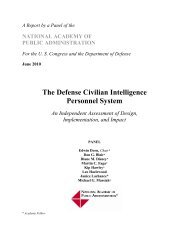Financial Management: Providing a Foundation for Transition - AGA
Financial Management: Providing a Foundation for Transition - AGA
Financial Management: Providing a Foundation for Transition - AGA
- No tags were found...
Create successful ePaper yourself
Turn your PDF publications into a flip-book with our unique Google optimized e-Paper software.
16• Many executives say their people are overworkedand eventually burn out, moving toanother entity or to the private sector. An executivesays, “You can have a busy season wheneveryone works more than 50 hours a week,but it can’t last all year.”Some of the suggestions our respondents offered<strong>for</strong> mitigating human capital risks come straightout of human resources and managementtextbooks. They are all sound practices <strong>for</strong> anyorganization, and include the following:“The easiest way to get people to work <strong>for</strong> you is to show themthat the work they do is relevant.”—An executiveSet up succession plans and invest in them.Succession planning is not just <strong>for</strong> executivesand managers, though. One executive says hisentity over hires <strong>for</strong> some positions where theyknow they will lose staff because of attrition,so they can train new people be<strong>for</strong>e incumbentemployees leave.Cross-train staff so that they can work in differentareas during surges. One CFO has heraccounting staff do contract closeouts whennecessary. “This short-term task will be part ofthe staff’s per<strong>for</strong>mance rating and will build theirskill sets,” she says, “The key is thinking outsideof narrowly defined divisions of labor like: that’saccounting, that’s acquisition.”Use intern programs to attract youngeremployees. Offering to pay off college loansmight attract more graduates.Offer rotational assignments to new professionalworkers (the Defense Finance andAccounting Agency’s Leaders in Motion programis an example).Train employees in new skills. Respondents saidthe <strong>AGA</strong>’s Certified Government <strong>Financial</strong> Manager(CGFM) program was a good investment.The next set of suggestions <strong>for</strong> mitigating humancapital risk is more particular to government.Flexibility. One major category of ideas has todo with becoming more flexible. This includes tostreamline government hiring processes, be moreflexible about salaries and bonuses (includingusing pay banding) and make it easier to movepeople around into different positions. In addition,some executives would like more hiring andfiring authority, as is the case with their privatesector counterparts.Retirement policies. A wave of Babyboomerretirements should make the government rethinkits retirement policies <strong>for</strong> public servants, sayseveral respondents. They think that the governmentcan do a better job of retaining federalemployees beyond their eligible retirement age(55 years with 30 years’ federal service), such asthrough part-time, flexible and flexiplace workschedules. Another option is to re-hire federalretirees, but in most cases current law reducestheir salaries by the amount of their pensions.This is no incentive <strong>for</strong> a talented retiree toreturn to an entity to work on temporary projects,fill critical skill gaps or train new employees.Some entities already have the flexibility to dothis, and the Office of Personnel <strong>Management</strong> isworking on ways to increase the practice.Quality of worklife. Many executives encouragetelecommuting, flextime and related programsto make it easier <strong>for</strong> employees to balance workand family life. Programs like telework require













